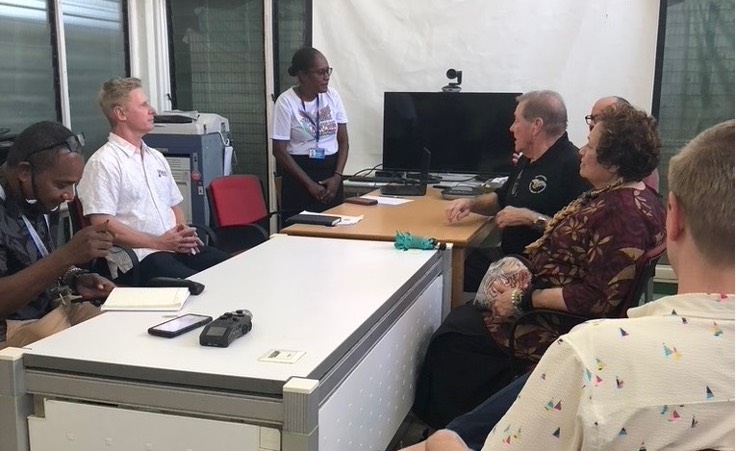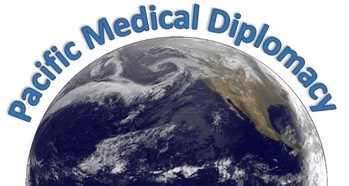The Pacific Islands Health Care Initiative – Redefining US Diplomacy in the Pacific Islands as Bold, Benevolent and Innovative
Since the signing of the Solomon Islands and China Security Agreement United States re-engagement in the Pacific Islands has been slow, congressional tardiness in passing the budget has not helped, but neither has the unimaginative approach to diplomacy. There is no shortage of ways the US can build people to people exchanges with Pacific Island Countries. Health as diplomacy should be at the top of the list. China is well aware of the power of health diplomacy and they deploy it quite effectively as is seen in PNG, Solomon Islands and Kiribati. The US can learn from the China Medical Team model. A few Congressional representatives recognize this and are pushing for US health diplomacy as a way to re-engage in the Pacific Region.
In August 2023, two members of congress traveled to Honiara, Solomon Islands. One of their priorities was to visit the National Referral Hospital (NRH) and meet with doctors and nurses on staff. For one hour Congressman Dr Neal Dunn and Congresswoman Amata Radewagen listened to how the NRH staff works, the challenges they face in providing care and what they need to improve their ability to care for the people of Solomon Islands.

On the heels of that visit Congresspersons Dunn, Case and Radewagen wrote to Secretary of State Blinken and Secretary of Interior Haaland asking them to support their Pacific Health Care Initiative (PHCI) during the second US Pacific Island Forum Leaders’ Summit. Unfortunately, despite initially expressing interest in the initiative PHCI was not a part of the Summit and of late has been overshadowed by current events in the Middle East. The US cannot neglect the Pacific Islands as it remains geopolitically important and in need of impactful programs in order to counter China’s influence. PHCI is one way to do that.
The PHCI calls for extending Veterans Administration health benefits not covered by the COFAs to those veterans living in the territories and Freely Associated States (FAS). This is a long overdue upgrade to benefits veterans in the region receive. According to the US State Department Bureau of East Asian and Pacific Affairs citizens of the Federated States of Micronesia volunteer at higher per capita rates than many U.S. states. FAS veterans should receive full VA benefits and to that end a VA Medical Center should be established in the Pacific Islands so a 5 hour flight to obtain care is avoided. In addition to calling for increased VA benefits the Pacific Health Care Initiative goes further by calling for “adopting a much larger initiative that would support health care building in the entire region.” One might think this is an overly ambitious proposal but when distilled down to what the biggest healthcare challenges are in the region it is actually quite doable.
The PHCI as it stands needs better defined goals and to advocate for a new approach toward funding. First, one must start by recognizing that the model of “us” delivering healthcare to “them” by sending short duration teams to hold clinics that operate in parallel to (and sometimes in competition with) local national health systems has limited value today. Health systems throughout the Pacific have staff, and infrastructure. The challenges these health systems currently face in delivering care include enhancing the skills and knowledge of the current healthcare workforce, increasing the numbers of new doctors, nurses, dentists and technicians working in the region and improving the hardscape of health system clinics and hospitals so they deliver quality care while standing up to the harsh tropical environment.
The PHCI should address five goals in order to succeed in bolstering US engagement in the region through sustainable health diplomacy while countering China’s Pacific reach.
- Strengthen education and skills of current Pacific Island Country healthcare workforce through coordinated bidirectional medical exchanges.
- Increase the number of healthcare workers (doctors, nurses, technicians) being trained in the region through collaborations with PIC universities.
- Support critical healthcare infrastructure development.
- Coordinate these programs and funding with other the members of the Partners in the Blue Pacific.
- Assist in the creation of regional medical centers of excellence such as cardiac and cancer care.
If enacted the PHCI will be a bold approach for the US to take. While American Samoa receives Pacific Basin health grants from US Health and Human Services and Health Resources and Services Administration, PHCI would be a first in delivering “health capacity” building to the wider Pacific Region. A program similar to PHCI was implemented in 2010 as part of the PEPFAR HIV/AIDS program in Sub Saharan Africa (SSA). PEPFAR incorporated “capacity building” programs at 12 SSA medical universities during a 5 year sunset program funded by HHS and NIH. That program included MEPI (Medical Education Partnership Initiative) and NEPI (Nursing Education Partnership Initiative). Both initiatives succeeded in keeping doctors and nurses working locally and in improving the quality of medical education as well as the quality of patient care.
PHCI would require changing the way current government agencies fund and support development programs. One strength to the PEPFAR MEPI and NEPI programs was how funding was handled. HHS and NIH essentially served as banks that released tranches of funding to US and SSA medical universities. The same can be done in funding the PHCI. USAID, the Department of Interior or any other agency, can serve as the fund holder, distributing monies through a US program coordinator working with participating US medical universities and a local Pacific Island coordinating center working with local medical schools, medical professional organizations and Ministries of Health. This approach would be a big departure from how USAID currently operates as control of the program is turned over to professional and educational entities, who know what is needed to meet the program’s goals. Adapting the way USAID and other US agencies fund programs could prove to be the hardest selling point of the PHCI as it requires agencies with entrenched operational rules to bend them.
The United States needs a bold, benevolent and innovative way to engage with the people of the Pacific Islands. Improving the skills, knowledge and numbers of healthcare workers throughout the Pacific Region will help them prepare for any health challenge they may face: emerging and endemic infectious diseases, rising rates of non-communicable diseases, trauma and road accidents, natural disasters and the promotion of preventive healthcare measures. Shoring up vulnerable and crumbling healthcare infrastructure will allow services to be seamless and assist in expanding treatment that each tier of care provides. The overarching goal of a health diplomacy program should be to level the playing field as best possible between PICs and the US in the delivery of health care. The Pacific Health Care Initiative is a forward facing proposal that deserves to be supported by congress, the Biden Administration and the Partners in the Blue Pacific.
